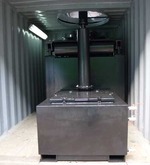Text and photos by Mallika Naguran
A stacked up 40ft container holds the answer to energy from waste with this STX MultiFEED.
Singapore, 28 June 2012. Strategic Petroleum, a Singapore-based company, has introduced a multi-feed gasification system to turn waste into energy. The STX MultiFEED is able to process different kinds of biomass and waste material simultaneously through molten metal gasification to produce syngas.
Syngas is synthetic gas formed through heating at high temperatures, comprising carbon monoxide, carbon dioxide and hydrogen. A byproduct generated is water. This system takes on a myriad of feedstock that includes paper, landfill waste, sewage, rubber tires, wood chips, low-rank coal, as well as agricultural biomass.
According to H.K. Gueh, managing director of Strategic Petroleum, 75 metric tonnes of waste can be fed into STX MultiFEED to produce about 1 MW of energy daily. The system is scalable from 50 to 3,000 tons a day.
Valves and pipes stream syngas out from lower to upper chamber in the STX MultiFEED system.
As it is built into a typical 40 foot shipping container, the system can be quickly set up once commissioned, and is portable. Two such containers are stacked one on top of the other, with the upper chamber serving to cool the reactor below that is heated at around 1500 degrees Celsius. A separate “mulcher” accompanies the system, serving to grind and slurry the feedstock before being fed into the reactor in the container.
“The core reactor is modular and that can be configured to generate different energy types,” says Gueh, who had spent nearly six years researching and developing the system. Patents protect the trademarked system for its proprietary gasification process, components and manufacturing methods.
Molten metal gasifier reactor.
There is an option to use only one, dual or multiple feedstock depending on the waste management company concerned, and the output can be electricity and water through combusion, methane with a methanation reactor or biodiesel through the Fischer–Tropsch process.
A single feed system costs US$1 million, while a multi-feed unit involves an investment of US$20 million. “At the base entry level, an investment of US$5 million will give a payback period of over 6 years,” says Gueh. The company claims to have the “world’s first commercially viable multi-feed gasifying system”.
A "mulcher" reduces waste into slurry before being fed into the molten metal STX MultiFEED gasifier.
Given the portability and scalability of the system, the potential for STX A "mulcher" reduces waste into slurry before being fed into the molten metal STX MultiFEED gasifier.MultiFEED to quickly provide waste management and energy solution is huge especially in remote areas, island countries, on tanker ships and at oil refineries. The system can also treat hazardous waste to produce stable granulated slag, and is capable of recovering rare materials.
This May, a 50-metric tonne system has been commissioned by First Qilin in the Juangsu Province of China to treat industrial and medical waste. Palm oil biomass entities in Malaysia have also expressed interest in the company’s offering. Singapore Petroleum is eyeing the European and American markets mostly due to the market-friendly renewable energy policies there.



